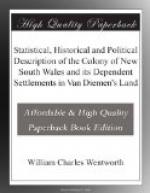The above general description may be applied with tolerable accuracy, to the whole tract of country which lies between this space and the Nepean River. The plains, however, on the banks of this river, which are in many places of considerable extent, are of far greater fertility, being a rich vegetable mould, many feet in depth, and have without doubt, been gradually formed by depositions from it during the periods of its inundations. These plains gradually enlarge themselves until you arrive at the junction of the Nepean with the Hawkesbury, on each side of which they are commonly from a mile to a mile and a half in breadth. The banks of this latter river are of still greater fertility than the banks of the former, and may vie in this respect with the far-famed banks of the Nile. The same acre of land there has been known to produce in the course of one year, fifty bushels of wheat and a hundred of maize. The settlers have never any occasion for manure, since the slimy depositions from the river, effectually counteract the exhaustion that would otherwise be produced by incessant crops. The timber on the banks of these rivers is for the most part apple tree, which is very beautiful, and bears in its foliage and shape a striking resemblance to the oak of this country. Its wood, however, is of no value except for firing, and for the immense quantity of pot-ash which might be made from it. The blue gum and stringy bark are also very common on these flooded lands, and of the best description. The banks of the Hawkesbury formerly produced cedar, but it has long since entirely disappeared.
The banks of these rivers, and indeed the whole tract of country, (generally speaking) which I have described, with the exception of the barren waste in the vicinity of the coast, are, to use the colonial term, located, i. e. either granted away to individuals, or attached as commons to the cultivated districts. It may not, therefore, be unacceptable to many of my readers, to learn the particulars of those unappropriated tracts of land within the immediate precincts of Port Jackson, which are best adapted to the purposes of colonization.
Cow pastures.
Of these “the cow pastures” rank first in point of proximity. This tract of land has hitherto been reserved for the use of the wild cattle; although these animals have for some time past disappeared, either from having found an outlet into the interior, through the surrounding mountains, or what is a still more probable conjecture, from the exterminating incursions of the numerous poor settlers, who have farms in the neighbourhood, and who, considering their general poverty, it is easy to believe, would not suffer the want of animal food, so long as they could take their dogs and guns, and kill a cow or calf at their option. These wild cattle were the progeny of a few tame ones, which strayed away from the settlement shortly after the period of its foundation, and were not discovered




